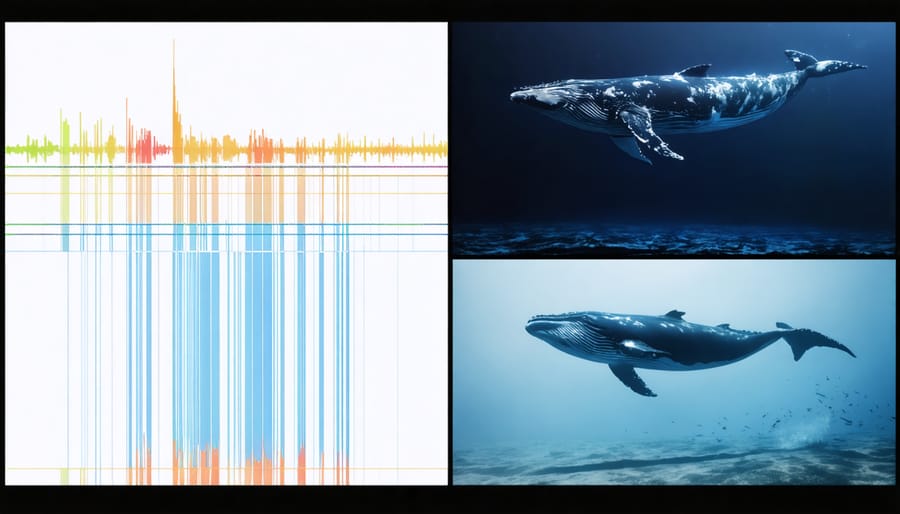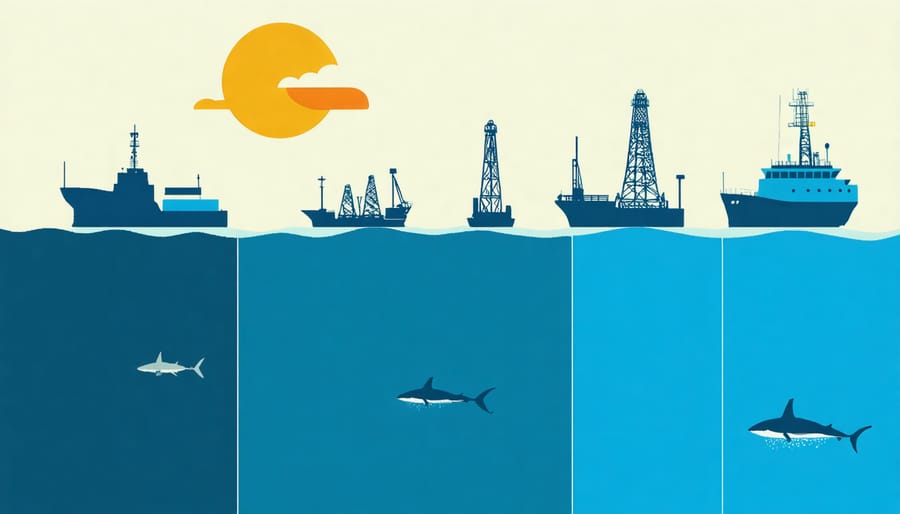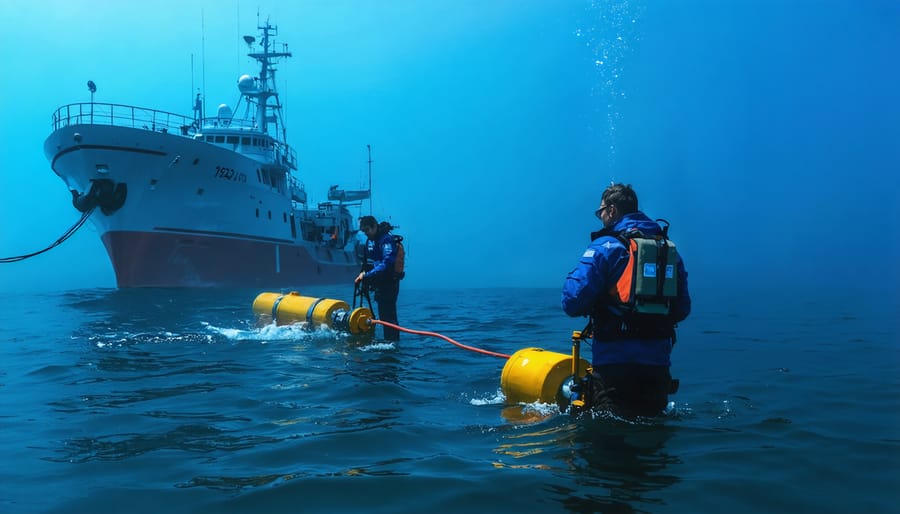
Beneath the ocean’s surface lies a hidden symphony that shapes marine life in ways we’re only beginning to understand. Ocean acoustics – the study of sound in marine environments – reveals a world where whale songs travel thousands of miles, coral reefs crackle with life, and the smallest organisms communicate through intricate acoustic signals. This vast underwater soundscape, essential for marine species’ survival, faces unprecedented challenges from human activities, from shipping noise to offshore construction.
Yet within this acoustic complexity lies both warning and wonder. Scientists now use advanced hydrophone networks to monitor ocean health, track endangered species, and understand climate change impacts through acoustic signatures. These underwater sound patterns serve as vital indicators of marine ecosystem stability, offering crucial insights for conservation efforts.
For marine researchers and conservationists, ocean acoustics represents more than just scientific data – it’s a window into the intricate relationships between marine life and their environment. Understanding these acoustic interactions has become increasingly urgent as human-generated noise threatens to disrupt natural marine processes, from breeding patterns to feeding behaviors.
This exploration of ocean acoustics not only advances our scientific knowledge but also strengthens our commitment to protecting the delicate balance of marine ecosystems for future generations.
The Natural Symphony of the Ocean
Marine Animal Communication
Marine animals have evolved sophisticated ways of using sound for survival and social interaction in the underwater world. Whales, particularly humpbacks and blue whales, produce complex songs that can travel hundreds of miles through the ocean. These vocalizations serve multiple purposes, from attracting mates to maintaining social bonds within pods.
Dolphins use echolocation, producing high-frequency clicks that bounce off objects and return as echoes, allowing them to navigate, hunt, and communicate with pod members. This biological sonar system is so precise that dolphins can detect fish hiding beneath the sand and distinguish between different species of prey.
Many fish species also rely on sound for communication. The male plainfin midshipman fish, for example, produces a distinctive humming sound during breeding season to attract females. Reef fish create popping, grunting, and croaking sounds to defend territory, coordinate group activities, and warn others of predators.
Even invertebrates contribute to the ocean’s acoustic landscape. Snapping shrimp create loud clicking sounds by rapidly closing their claws, producing bubble cavitation that can be heard for considerable distances. These sounds serve both as communication signals and hunting mechanisms.
The timing and frequency of these marine animal vocalizations often adapt to environmental conditions, demonstrating the sophisticated nature of underwater acoustic communication. Understanding these communication patterns helps scientists monitor population health and assess the impact of human activities on marine ecosystems.

Geophysical Sound Sources
The ocean is a symphony of natural sounds, each telling a unique story about our planet’s dynamic processes. Wave action creates a constant background chorus, varying in intensity from gentle lapping at the surface to thunderous crashes during storms. When waves break, they trap air bubbles that produce distinctive sounds as they rise and burst, contributing to what scientists call the “ambient noise” of the ocean.
Seismic events, including earthquakes and underwater volcanic eruptions, generate powerful low-frequency sounds that can travel thousands of kilometers through the ocean. These geophysical events create distinctive acoustic signatures that help scientists monitor tectonic activity and understand Earth’s geological processes.
Precipitation also plays a crucial role in ocean acoustics. When raindrops hit the water’s surface, they create unique sound patterns that vary depending on the size of the drops and intensity of the rainfall. Heavy rain can increase underwater noise levels by up to 35 decibels, equivalent to the difference between a quiet room and a busy restaurant.
Ice activity in polar regions adds another dimension to oceanic soundscapes. The cracking, grinding, and melting of ice sheets produce distinctive sounds that scientists use to monitor climate change impacts. These “ice songs” can range from sharp, pistol-like cracks to long, haunting moans that reverberate through the water.
Together, these natural sound sources create a complex acoustic environment that marine life has evolved to navigate and utilize for millions of years.
Human Impact on Ocean Soundscapes
Shipping and Industrial Noise
The increasing presence of commercial vessels in our oceans has dramatically altered the underwater soundscape over the past century. Large cargo ships, which now number in the tens of thousands globally, generate persistent low-frequency noise that can travel hundreds of kilometers through water. This acoustic footprint has created what scientists call “acoustic smog,” significantly impacting marine life that relies on sound for survival.
Commercial shipping routes, particularly in coastal areas and major ports, have become underwater noise highways. The continuous drone of ship engines and propellers can mask important biological sounds used by marine mammals for communication, navigation, and finding food. Studies have shown that shipping noise typically ranges from 10 to 200 Hz, overlapping with the communication frequencies of many whale species.
Beyond shipping, industrial activities like offshore construction, seismic exploration, and destructive fishing practices contribute significantly to ocean noise pollution. The installation of offshore wind turbines, while beneficial for renewable energy, creates intense sound pulses that can temporarily displace marine life from their habitats.
The good news is that technological solutions are emerging. Ship designers are developing quieter propulsion systems, and some ports have implemented voluntary vessel slowdown programs to reduce noise levels. Many marine biologists are working with shipping companies to create “quiet zones” in areas of high biological importance, demonstrating how industry and conservation can work together for positive change.

Consequences for Marine Life
The impact of human-generated noise on marine life extends far beyond mere disturbance, creating a cascade of effects that threatens entire ocean ecosystems. Like toxic pollutants in our oceans, acoustic pollution poses serious risks to marine species’ survival and behavior.
Marine mammals, particularly whales and dolphins, rely heavily on sound for navigation, communication, and finding food. When exposed to excessive noise from shipping, military sonar, or offshore construction, these creatures often exhibit signs of severe stress. Many species alter their migration routes, abandoning traditional feeding grounds and breeding areas to escape the cacophony of human activity.
Fish populations face similar challenges. Studies show that persistent noise interference can mask the sounds fish use to detect predators and locate potential mates. This disruption affects their reproductive success and survival rates. Even coral reef inhabitants, which depend on the subtle sounds of healthy reefs to guide larval settlement, struggle to maintain their populations in acoustically polluted environments.
Perhaps most concerning is the impact on marine species’ ability to communicate effectively. Whale songs, crucial for maintaining social bonds and coordinating group movements, can be drowned out by commercial shipping noise. Scientists have observed whales attempting to compensate by “shouting” – calling at higher volumes and frequencies – which requires more energy and creates additional stress.
The good news is that marine life shows remarkable resilience when given the chance to recover. When shipping decreased during recent global events, researchers documented immediate positive changes in whale communication patterns and stress hormone levels, demonstrating that reducing noise pollution can have swift and significant benefits for marine ecosystems.
Monitoring and Conservation Efforts

Scientific Research Tools
Scientists use sophisticated tools to study and monitor ocean acoustics, with hydrophones being the primary instrument for underwater sound detection. These underwater microphones are specially designed to withstand extreme pressures and harsh marine conditions while capturing a wide range of frequencies from the lowest whale calls to the highest dolphin clicks.
Modern hydrophone arrays can be deployed in various configurations, from stationary networks anchored to the seafloor to mobile systems attached to research vessels or autonomous underwater vehicles. These arrays help scientists create detailed acoustic maps of marine environments and track animal movements across vast oceanic regions.
Complementing hydrophones, researchers also employ Acoustic Doppler Current Profilers (ADCPs) to measure water movement and understand how sound travels through different ocean layers. Sound Velocity Profilers (SVPs) provide crucial data about water temperature, salinity, and pressure – factors that significantly influence acoustic propagation.
Data logging systems have evolved to become more sophisticated, with some capable of real-time transmission to shore-based facilities via satellite links. This immediate access to acoustic data helps scientists respond quickly to unusual events or changes in marine mammal behavior.
For analyzing collected data, specialized software helps researchers isolate specific sounds, identify species, and track acoustic patterns over time. Machine learning algorithms are increasingly being employed to process the vast amounts of acoustic data collected, helping to identify and classify marine species automatically.
Conservation Success Stories
Acoustic monitoring has played a pivotal role in several successful marine conservation initiatives, demonstrating the power of sound science in protecting ocean life. In the waters off Boston Harbor, researchers used passive acoustic monitoring to track the recovery of endangered right whales, leading to the implementation of dynamic shipping lanes that reduced vessel strikes by 80% over five years.
The Great Barrier Reef’s “Reef Recording Project” exemplifies another triumph, where acoustic monitoring helped identify previously unknown spawning grounds of crucial fish species. This discovery led to the establishment of targeted protection zones, resulting in a 45% increase in fish populations within these areas.
In the Mediterranean, the success of “Project NEPTUNE” showcases how acoustic technology can protect marine mammals. By deploying a network of hydrophones, scientists created an early warning system for ship captains, reducing whale collisions by 65% in high-traffic areas.
Perhaps most inspiring is the Hawaiian Islands Humpback Whale National Marine Sanctuary’s acoustic monitoring program, where citizen scientists contribute to data collection. This community-driven approach has not only improved our understanding of whale behavior but has also strengthened public engagement in marine conservation, leading to enhanced protection measures and a remarkable 90% recovery in the local humpback whale population.
Taking Action: How You Can Help
Everyone can play a vital role in protecting marine life from harmful underwater noise pollution, which is an often-overlooked aspect of the broader ocean pollution crisis. Here are several meaningful ways you can contribute to ocean acoustic conservation:
Support Noise Reduction Initiatives
– Sign petitions advocating for quieter shipping lanes and marine protected areas
– Join local marine conservation groups that focus on noise pollution
– Support organizations developing noise-reduction technologies for marine vessels
Reduce Your Personal Impact
– Choose eco-friendly tour operators who follow responsible wildlife viewing guidelines
– When boating, maintain slower speeds in marine mammal habitats
– Keep boat engines well-maintained to minimize unnecessary noise
– Use quieter electric motors when possible for recreational vessels
Citizen Science Participation
– Download marine mammal tracking apps to report sightings
– Volunteer for acoustic monitoring programs at local marine research centers
– Participate in beach cleanup events that include hydrophone demonstrations
– Join community science projects that track marine mammal behavior
Spread Awareness
– Share information about ocean noise pollution on social media
– Organize educational events in your community
– Encourage local schools to include ocean acoustics in their curriculum
– Start conversations about the importance of quiet oceans
Make Informed Consumer Choices
– Support companies committed to noise-reduction practices in marine shipping
– Choose products transported via companies using noise-minimizing technologies
– Research and support marine-friendly tourism operators
Educational Involvement
– Attend workshops and seminars about marine acoustics
– Take online courses about ocean conservation
– Visit marine science centers and aquariums
– Share educational resources with your community
Remember, every action counts. By combining individual efforts with community involvement, we can create significant positive change for marine life affected by ocean noise pollution.
Ocean acoustics plays a vital role in understanding and protecting our marine ecosystems. Throughout this exploration, we’ve discovered how sound travels through water, its importance in marine life communication, and the growing challenges of ocean noise pollution. From the haunting songs of humpback whales to the complex clicking patterns of dolphins, these acoustic signals form the backbone of marine species’ survival strategies.
We’ve also learned about the innovative technologies and research methods used to study ocean acoustics, including hydrophones, sonar systems, and acoustic mapping techniques. These tools not only help us understand marine life better but also enable us to monitor and protect vulnerable species and habitats.
The impact of human-generated noise on marine ecosystems cannot be understated. However, there is hope through collective action. By supporting noise reduction initiatives, advocating for quieter shipping technologies, and participating in citizen science projects, we can all contribute to preserving the natural soundscape of our oceans.
Whether you’re a student, researcher, or concerned citizen, there are numerous ways to get involved. Consider joining local marine conservation groups, supporting acoustic research programs, or simply spreading awareness about ocean noise pollution. Together, we can work toward ensuring that future generations will still hear the symphony of the seas, undisturbed by human interference.
The time to act is now. Our oceans’ acoustic health reflects the overall well-being of marine ecosystems, and protecting it is crucial for the survival of countless species that call the ocean their home.
jessica
Ava Singh is an environmental writer and marine sustainability advocate with a deep commitment to protecting the world's oceans and coastal communities. With a background in environmental policy and a passion for storytelling, Ava brings complex topics to life through clear, engaging content that educates and empowers readers. At the Marine Biodiversity & Sustainability Learning Center, Ava focuses on sharing impactful stories about community engagement, policy innovations, and conservation strategies. Her writing bridges the gap between science and the public, encouraging people to take part in preserving marine biodiversity. When she’s not writing, Ava collaborates with local initiatives to promote eco-conscious living and sustainable development, ensuring her work makes a difference both on the page and in the real world.
